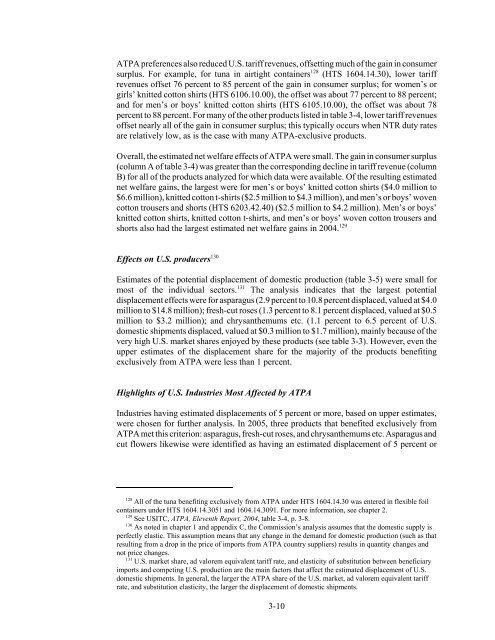The Impact of the Andean Trade Preference Act Twelfth ... - USITC
The Impact of the Andean Trade Preference Act Twelfth ... - USITC
The Impact of the Andean Trade Preference Act Twelfth ... - USITC
- No tags were found...
Create successful ePaper yourself
Turn your PDF publications into a flip-book with our unique Google optimized e-Paper software.
ATPA preferences also reduced U.S. tariff revenues, <strong>of</strong>fsetting much <strong>of</strong> <strong>the</strong> gain in consumersurplus. For example, for tuna in airtight containers 128 (HTS 1604.14.30), lower tariffrevenues <strong>of</strong>fset 76 percent to 85 percent <strong>of</strong> <strong>the</strong> gain in consumer surplus; for women’s orgirls’ knitted cotton shirts (HTS 6106.10.00), <strong>the</strong> <strong>of</strong>fset was about 77 percent to 88 percent;and for men’s or boys’ knitted cotton shirts (HTS 6105.10.00), <strong>the</strong> <strong>of</strong>fset was about 78percent to 88 percent. For many <strong>of</strong> <strong>the</strong> o<strong>the</strong>r products listed in table 3-4, lower tariff revenues<strong>of</strong>fset nearly all <strong>of</strong> <strong>the</strong> gain in consumer surplus; this typically occurs when NTR duty ratesare relatively low, as is <strong>the</strong> case with many ATPA-exclusive products.Overall, <strong>the</strong> estimated net welfare effects <strong>of</strong> ATPA were small. <strong>The</strong> gain in consumer surplus(column A <strong>of</strong> table 3-4) was greater than <strong>the</strong> corresponding decline in tariff revenue (columnB) for all <strong>of</strong> <strong>the</strong> products analyzed for which data were available. Of <strong>the</strong> resulting estimatednet welfare gains, <strong>the</strong> largest were for men’s or boys’ knitted cotton shirts ($4.0 million to$6.6 million), knitted cotton t-shirts ($2.5 million to $4.3 million), and men’s or boys’ wovencotton trousers and shorts (HTS 6203.42.40) ($2.5 million to $4.2 million). Men’s or boys’knitted cotton shirts, knitted cotton t-shirts, and men’s or boys’ woven cotton trousers andshorts also had <strong>the</strong> largest estimated net welfare gains in 2004. 129Effects on U.S. producers 130Estimates <strong>of</strong> <strong>the</strong> potential displacement <strong>of</strong> domestic production (table 3-5) were small formost <strong>of</strong> <strong>the</strong> individual sectors. 131 <strong>The</strong> analysis indicates that <strong>the</strong> largest potentialdisplacement effects were for asparagus (2.9 percent to 10.8 percent displaced, valued at $4.0million to $14.8 million); fresh-cut roses (1.3 percent to 8.1 percent displaced, valued at $0.5million to $3.2 million); and chrysan<strong>the</strong>mums etc. (1.1 percent to 6.5 percent <strong>of</strong> U.S.domestic shipments displaced, valued at $0.3 million to $1.7 million), mainly because <strong>of</strong> <strong>the</strong>very high U.S. market shares enjoyed by <strong>the</strong>se products (see table 3-3). However, even <strong>the</strong>upper estimates <strong>of</strong> <strong>the</strong> displacement share for <strong>the</strong> majority <strong>of</strong> <strong>the</strong> products benefitingexclusively from ATPA were less than 1 percent.Highlights <strong>of</strong> U.S. Industries Most Affected by ATPAIndustries having estimated displacements <strong>of</strong> 5 percent or more, based on upper estimates,were chosen for fur<strong>the</strong>r analysis. In 2005, three products that benefited exclusively fromATPA met this criterion: asparagus, fresh-cut roses, and chrysan<strong>the</strong>mums etc. Asparagus andcut flowers likewise were identified as having an estimated displacement <strong>of</strong> 5 percent or128All <strong>of</strong> <strong>the</strong> tuna benefiting exclusively from ATPA under HTS 1604.14.30 was entered in flexible foilcontainers under HTS 1604.14.3051 and 1604.14.3091. For more information, see chapter 2.129 See <strong>USITC</strong>, ATPA, Eleventh Report, 2004, table 3-4, p. 3-8.130 As noted in chapter 1 and appendix C, <strong>the</strong> Commission’s analysis assumes that <strong>the</strong> domestic supply isperfectly elastic. This assumption means that any change in <strong>the</strong> demand for domestic production (such as thatresulting from a drop in <strong>the</strong> price <strong>of</strong> imports from ATPA country suppliers) results in quantity changes andnot price changes.131U.S. market share, ad valorem equivalent tariff rate, and elasticity <strong>of</strong> substitution between beneficiaryimports and competing U.S. production are <strong>the</strong> main factors that affect <strong>the</strong> estimated displacement <strong>of</strong> U.S.domestic shipments. In general, <strong>the</strong> larger <strong>the</strong> ATPA share <strong>of</strong> <strong>the</strong> U.S. market, ad valorem equivalent tariffrate, and substitution elasticity, <strong>the</strong> larger <strong>the</strong> displacement <strong>of</strong> domestic shipments.3-10
















